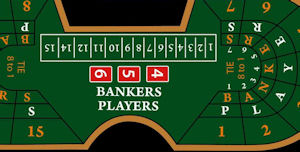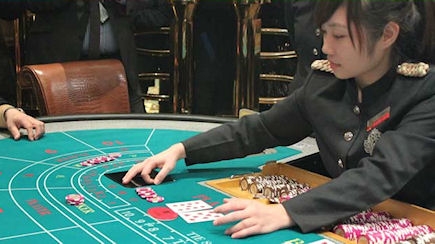This article first appeared in the Mar/Apr 2012 issue of World Gaming magazine.
Our tournament baccarat guru continues his fascinating series on the little-known art of winning baccarat tournaments.
Welcome to part F of this series. Visit World Gaming’s website wgm8.com if you need to catch up on parts A, B, C, D and E which explained:
- Introductory concepts such as:
- rounds, heats and finals
- star position
- the three distinct phases of any baccarat tournament: the early going, the middle going and the late going (or the “death”)
- how to know which phase you are in at any given moment
- the strategies to implement during the early going
- “the progression”, a powerful “chasing” technique that can be used in the early and middle going
- identification of your most serious opponent(s)
- knowing how to classify yourself as either “betting first” or “betting last” (this is not as straightforward as it may seem)

You’ll need to understand all of the above to understand the rest of this article. At the end of part E, I explained that for each hand during the middle going, right up to the second last hand of the tournament, you’ll be able to classify yourself as being in one of four situations:
- Star position and betting last
- Star position and betting first
- Not star position and betting last
- Not star position and betting first
There is an optimal strategy for each of these four situations. Let’s examine each of them.
Star position, betting last
Betting last is a massive advantage.
Poker players refer to this as being “in position” and understand the huge advantage it brings. The advantage of position in tournament baccarat is even greater than it is in poker.
You are in star position, and of course you want to stay there. This means making it as difficult as possible for your opponent to catch you. Since you are betting last, this is fairly easy – just match your opponent’s bet! This is known as a “flow” bet, or “flowing” your opponent. For example, say you have 200,000 chips and your opponent is sitting on 150,000 chips. Your opponent bets 40,000 chips on player. Now you bet 40,000 chips on player. No matter what happens in the hand, you will still be 50,000 chips ahead of your opponent at the end of the hand. Easy!
If you have multiple opponents, it’s not so easy. In this case, you try to pick a bet that flows or at least closely flows all or most of your opponents, with a weighting towards more closely flowing your most serious opponent or alternatively the majority of your opponents. Let me explain with some examples:
You: 300,000 chips
Opponent A: 200,000 chips, bets 50,000 on banker (leaving 150,000 behind)
Opponent B: 180,000 chips, bets 100,000 on banker (leaving 80,000 behind)
Maximum bet: 200,000 chips
I suggest: The good news is they both bet on the same side, banker. So you bet on banker. One bet 50,000 and the other 100,000, so you bet somewhere in the middle. The difference between your bet and their bets is less than your lead at the start of the hand, so no matter what side wins, you will still be in front of both your opponents after the hand is over. That’s a great result for you. They both have very similar stacks, so somewhere close to halfway between their bets makes sense. Since opponent A has a little more chips, I would lean slightly towards his bet, and go with a bet of 70,000 on banker.
You: 500,000 chips
Opponent A: 400,000 chips, bets 100,000 on player (leaving 300,000 behind)
Opponent B: 300,000 chips, bets 250,000 on banker (leaving 50,000 behind)
Opponent C: 250,000 chips, moves all-in 250,000 on banker (leaving 0 behind)
Maximum bet: 300,000 chips
I suggest: This is a tough one to pick a good flow bet. Your most serious opponent (opponent A) has bet 100,000 on player, so that suggests you do the same. But if you do that and banker wins, both opponents B and C will overtake you. In this case, I actually suggest betting say 200,000 on banker. If banker wins you are still well clear of B and C and if player wins you only have one opponent to catch, and you are still within striking distance of him as you can move all-in next hand.
Star position, betting first
Once again you are trying to flow your most serious opponent(s), but now you don’t have the luxury of seeing their bet(s) first. The default technique here is simply to bet the minimum, so the maximum “swing” your opponent(s) can get if they win is one maximum bet plus a minimum bet. A “swing” is the difference between the results of your bets. To illustrate, if you bet minimum on banker and they bet maximum on player, and player wins, they will win a maximum bet and you will lose a minimum bet, so the swing is a maximum plus a minimum bet. But if you bet maximum, and they are clever enough to bet maximum on the other side, and that other sides wins, they catch you by two maximum bets. This is a double maximum bet swing, so they catch up to you faster.
Another way to think of a swing is the movement in the difference between two stacks, as a result of any given result (banker or player). For example, if person A bets 10,000 on player and person B bets 20,000 on player, the swing will be 10,000 chips, no matter what side wins the hand. If player wins, B will get a 10,000 positive swing on A. If banker wins, A will get a 10,000 positive swing on B.
Another strategy in this situation is to try to guess what your opponent(s) might bet based upon their prior betting or demonstrated thought patterns, and bet similarly. If they are unskilled tournament players who don’t have a lot of situational awareness this strategy can work well. But remember for every chip you bet more than the minimum bet, you are giving them a chance to get an extra chip swing on you if they are clever enough to bet maximum on the other side.

Not star position, betting last
You need to get to star position. You do that by overtaking the player with the smallest chip stack who is in star position. Your goal is to catch that player. To do that, you need to get a swing on that player, by betting “contrary” to him. Simply look at the target player, and bet on the side opposite to the side he bet on by enough to catch him if you win. You might consider using a progression as explained in part D of this series. If you can’t bet an amount that catches him if you win, simply bet the maximum you can. If that means moving all-in, so be it. You don’t have time to wait anymore – the waiting game was for the early going. In the middle going you have to get to star position, and stay there.
Examples:
You: 390,000 chips
Opponent: 500,000 chips, bets 10,000 on player (leaving 490,000 behind)
Maximum bet: 300,000 chips
I suggest: Bet 130,000 on banker. If you win, you’ll win 123,500 (don’t forget the 5 percent commission on winning banker bets) and he’ll lose 10,000 – a swing of 133,500 chips, putting you just 23,500 chips in front of him. It doesn’t matter that you’re only just ahead of him. An inch is as good as a mile when the chips are counted at the end of the round! If you lose, you can still move all-in next hand.
You: 70,000 chips
Opponent: 300,000 chips, bets 10,000 on banker (leaving 290,000 behind)
Maximum bet: 200,000 chips
I suggest: You have to shove all-in. Bet your entire 70,000. Since he bet on banker, you bet on player, and get an 80,000 chip swing on him if you win. If you lose, you’ll be out of the tournament, and if you win, you’ll probably have to shove all-in again next hand, to try to take the star position.
Not star position, betting first
This is the toughest situation of the four. You need to get to star position, and you don’t know what your opponent is going to bet. Try to make it hard for your opponent to flow you. Bet at least the difference between your two stacks, if not more. If in doubt, bet the maximum. Sometimes you get lucky and your opponent isn’t clever enough to flow you. Other times he might be clever enough to know he needs to flow his opponents, but he might not perceive you to be his most serious opponent. If this is likely (or even possible), definitely bet the opposite side of the players who you think he might perceive as his serious opponents (assuming you bet after those players). Essentially, try to guess which side he is most likely to bet, and you get on the other side.
If the tournament uses secret bets (and most tournaments do), this is a perfect scenario for using one of your secret bets. I will have more to say about secret bets later in this series, but using a secret bet in this scenario reduces the chance you will be flowed, since your opponent(s) will not know how much you have bet, nor which side you have bet on.
If you are totally stumped about which side to bet on, go with banker, since it wins very slightly more often than player.
Examples:
You: 27,000 chips
Opponent: 100,000 chips
Maximum bet: 50,000 chips
I suggest: Just move all-in on the side you think he is least likely to bet on.
You: 6 million chips
Opponent: 8 million chips
Maximum bet: 10 million chips
I suggest: You could bet say 2.2 million on the side you think he won’t bet on. If he flows you, and it becomes apparent he will continue to flow you, and you are not going to get a chance to bet after him, or use a secret bet, simply move all-in for your entire 6 million chip stack on the side you think he is less likely to bet on. Betting 6 million (as opposed to 2.2 million) might make him more nervous about flowing you, depending on the chip stacks and bets of the other players. You have very little to lose by betting 6 million instead of 2.2 million if you are stuck in this horrible position, as you simply must catch this player to have any shot of winning the tournament (or progressing to the next round).
In the next part of the series, we move from the middle going to the all-important late going, which consists of just one single hand: the final hand. This is the most important hand of the tournament. I’ll show you how to master that crucial final hand and get a big advantage over your opponents.







